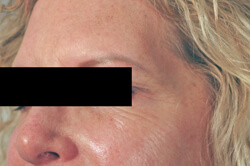

As we age, subtle but noticeable changes begin to appear in our face. One of the earliest and most overlooked signs of aging is temporal hollowing — a loss of volume in the temple area that can make the upper face appear more sunken and angular. While it’s a natural part of the aging process, it can significantly affect facial balance and overall appearance.
What Is Temporal Hollowing?
Temporal hollowing refers to the loss of fat and soft tissue in the temples — the areas between the eyes and the hairline. When this happens, the temples start to look indented or hollow, giving the upper face a thinner, more skeletal look. This condition doesn’t just change the shape of the temples; it also affects how the eyes and brows are perceived since they’re all part of the same frame.
Why Does Temporal Hollowing Happen?
There are a few reasons why temporal hollowing occurs, but the main cause is age-related volume loss. As we grow older, the fat pads, muscles, and connective tissues that support our face start to thin out and descend. This loss of support is especially visible in the temples, where there’s already less natural fat compared to other areas of the face.
Other contributing factors can include:
- Genetics: Some people naturally have less volume in their temples.
- Weight loss: Rapid or significant weight loss can make hollowing more noticeable.
- Sun exposure: UV damage accelerates collagen breakdown, leading to thinner skin.
- Lifestyle factors: Stress, dehydration, or poor nutrition can worsen the hollowed look.
How Temporal Hollowing Affects Facial Appearance
The temples may seem like a small part of the face, but they play a big role in framing the eyes and balancing the upper facial structure. When the temples lose volume, the face can look tired, aged, or even unhealthy. The smooth contour between the forehead, temple, and cheeks starts to disappear, which can make the eyes look deeper set and the overall appearance less vibrant.
How Do You Fix Temporal Hollowing?
Fortunately, dermal fillers offer an effective and non-surgical solution for restoring volume to the temples. Fillers like Juvederm or Restylane, made from hyaluronic acid, can be carefully injected to replace lost volume and recreate a smooth contour.
By filling the temporal hollows:
- The upper face regains a balanced shape.
- The eyes appear brighter and more open.
- The overall facial harmony improves without looking “done” or artificial.
The procedure is quick, typically taking less than 30 minutes, with minimal downtime. Most patients notice an immediate improvement, and the results can last from 9 to 18 months, depending on the filler used and individual metabolism.
The Benefits Go Beyond the Temples
Treating temporal hollowing doesn’t just fill one area — it subtly enhances the entire face. By restoring lost volume, the temples once again frame the eyes beautifully, giving a refreshed and more youthful look. Many patients say they look “well-rested” rather than “treated,” which is exactly the goal of natural facial rejuvenation.
Final Thoughts
Temporal hollowing may be a normal part of aging, but it doesn’t have to define your appearance. With precise filler treatments performed by a skilled injector, you can restore natural volume, rebalance your features, and bring youthful softness back to your face.
If you’ve noticed your temples starting to look sunken or your upper face losing fullness, talk to a qualified aesthetic professional. A personalized consultation can help you understand whether temple filler is right for you and how it can enhance your overall facial harmony.

